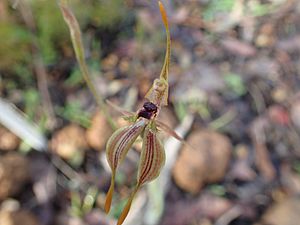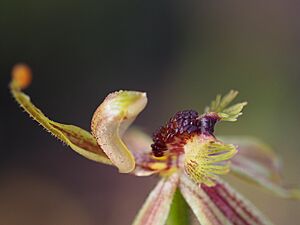Crab-lipped spider orchid facts for kids
Quick facts for kids Crab-lipped spider orchid |
|
|---|---|
 |
|
| Caladenia plicata growing in Mount Barker | |
| Scientific classification | |
| Genus: |
Caladenia
|
| Species: |
plicata
|
| Synonyms | |
|
<
|
|
The crab-lipped spider orchid (scientific name: Caladenia plicata) is a special type of orchid. It grows only in the south-west part of Western Australia. This orchid has a single leaf that feels hairy. Its flowers are red, yellow, and pale green. They have a unique part called a labellum that wiggles even with a tiny bit of wind.
What Does It Look Like?
The crab-lipped spider orchid is a plant that grows from the ground. It is a perennial plant, meaning it lives for more than two years. It is also deciduous, so some parts might die back in certain seasons. This plant has an underground tuber (like a small potato) and one straight, hairy leaf. The leaf is usually about 8 to 20 centimetres (3 to 8 inches) long and 6 to 12 millimetres (0.2 to 0.5 inches) wide.
The orchid usually has one or two flowers. These flowers are red, yellow, and pale green with red marks. They are about 3 to 5 centimetres (1 to 2 inches) long and 3 to 4 centimetres (1 to 1.5 inches) wide. The flowers grow on a stem that is about 16 to 35 centimetres (6 to 14 inches) tall.
Flower Parts
- Sepals: These are like small leaves that protect the flower. The sepals of this orchid have thick, brown, club-like tips. These tips are about 3 to 5 millimetres (0.1 to 0.2 inches) long.
- The top sepal stands straight up. It is about 2 to 2.5 centimetres (0.8 to 1 inch) long and 2 millimetres (0.08 inches) wide.
- The side sepals are about 2 to 2.5 centimetres (0.8 to 1 inch) long and 4 millimetres (0.16 inches) wide. They curve downwards and stay parallel to each other.
- Petals: These are the colourful parts of the flower. The petals are about 2 to 2.5 centimetres (0.8 to 1 inch) long and 2 millimetres (0.08 inches) wide. They also curve downwards.
- Labellum: This is the special "lip" of the orchid. It is about 6 to 8 millimetres (0.2 to 0.3 inches) long and 9 to 11 millimetres (0.35 to 0.43 inches) wide. It can be red or sometimes pale green. This labellum is famous for wiggling with even the smallest breath of air! The sides of the labellum curve down. They have many spreading "teeth" up to 4 millimetres (0.16 inches) long. In the middle of the labellum, there is a thick band of dark red bumps called calli. These calli can be up to 3 millimetres (0.12 inches) long.
This orchid usually blooms from September to early November.
How It Got Its Name
The Caladenia plicata was first officially described in 1882. A botanist named Robert D. FitzGerald wrote about it in a gardening magazine called The Gardeners' Chronicle.
Fitzgerald wrote that this orchid was "a very hairy species, about 1 foot high." He also mentioned its most interesting feature: "The labellum is constantly moving up and down with the slightest breath of air."
The second part of its scientific name, plicata, comes from a Latin word. It means "fold." This name refers to the unusual folded shape of the orchid's labellum.
Where It Lives
The crab-lipped spider orchid is quite common in its home area. It grows in many different types of forests. You can often find it in thick groups of Casuarina trees.
This orchid is found in Western Australia. It grows between the towns of Nannup and Hopetoun. These areas include the Esperance Plains, Jarrah Forest, Swan Coastal Plain, and Warren regions.
Is It Protected?
The Western Australian Government's Department of Parks and Wildlife has looked at the Caladenia plicata. They have classified it as "not threatened." This means the orchid is not currently in danger of disappearing.


